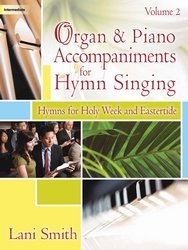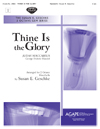- |
User Links
187
Thine Is the Glory
Hymn Information
- First Line
- Thine is the glory
- Author
- Edmond Budry, 1854-1932
- Translator
- R. Birch Hoyle, 1875-1939
- Tune Name
- JUDAS MACCABAEUS
- Composer
- George Frideric Handel, 1685-1759
- Topic
- Church Year: Easter/Season of Easter · Hymns About Worship
Copyright Information
- Text Copyright
- Public Domain
- Tune Copyright
- Public Domain
- Reprint/Projection Information
- Words and Music: The Words and Music are in the Public Domain; you do not need permission to project or reprint the Words and Music.
Full Text
Scripture References
Confessions and Statements of Faith References
Further Reflections on Confessions and Statements of Faith References
Easter hymns accomplish three functions: they recount the Easter narrative, proclaim our Easter hope, and celebrate our joy at Christ’s resurrection. This hymn is built on the professions of Easter truths that are expressed primarily in Heidelberg Catechism. Note especially the following:
- Lord’s Day 17, Question and Answer 45 declares that Christ’s resurrection makes us share in Christ’s righteousness, raises us to a new life by his power, and is a sure pledge to us of our resurrection.
- Lord’s Day 22, Question and Answer 57 comforts us to know that not only our soul but “also my very flesh will be raised by the power of God, reunited with my soul, and made like Christ’s glorious body.”
- Lord’s Day 22, Question and Answer 58 says that it may be a comfort to know that while experiencing the beginning of eternal joy now, “after this life I will have perfect blessedness such as no eye has seen, no ear has heard, no human heart has ever imagined: a blessedness in which to praise God forever.”
In addition, Our Song of Hope, stanza 5 professes: “On the day of the resurrection, the tomb was empty; His disciples saw Him; death was defeated; new life had come. God’s purpose for the world was sealed.”
187
Thine Is the Glory
Call to Worship
Jesus said, “I have come that they may have life,
and may have it to the full.”
—from John 10:10, NIV
—
Worship Sourcebook Edition Two
Worthy is the Lamb that was slaughtered
to receive power and wealth and wisdom and might
and honor and glory and blessing!
—Revelation 5:12, NRSV
—
Worship Sourcebook Edition Two
The Lord who calls us to worship today is the same Jesus
who refused the temptation to worship the evil one.
Rather than receive the glorious kingdoms of this world,
he endured the shame of the cross,
and today is Lord of lords and King of kings.
Now are gathered in him
all the treasures of wisdom and knowledge,
glory and power.
With the saints of all ages we say,
“Worthy is the Lamb, who was slain,
to receive power and wealth and wisdom
and strength and honor and glory and praise!”
—based on Colossians 2:3; Revelation 5:12, NIV
[Reformed Worship 27:40]
—
Worship Sourcebook Edition Two
Words of Praise
Glory to you, O God:
On this day you won victory over death,
raising Jesus from the grave
and giving us eternal life.
Glory to you, O Christ:
For us and for our salvation you overcame death
and opened the gate to everlasting life.
Glory to you, O Holy Spirit:
You lead us into the truth.
Glory to you, O blessed Trinity,
now and forever. Amen.
[BCW-1946, pg 304, alt., PD]
—
Worship Sourcebook Edition Two
In life and in death we belong to God.
Through the grace of our Lord Jesus Christ,
the love of God,
and the communion of the Holy Spirit,
we trust in the one triune God, the Holy One of Israel,
whom alone we worship and serve.
We trust in Jesus Christ,
fully human, fully God.
Jesus proclaimed the reign of God:
preaching good news to the poor
and release to the captives,
forgiving sinners,
and calling all to repent and believe the gospel.
Unjustly condemned for blasphemy and sedition,
Jesus was crucified,
suffering the depths of human pain
and giving his life for the sins of the world.
God raised Jesus from the dead,
vindicating his sinless life,
breaking the power of sin and evil,
delivering us from death to life eternal.
With believers in every time and place,
we rejoice that nothing in life or in death
can separate us from the love of God in Christ Jesus, our Lord.
Glory be to the Father, and to the Son, and to the Holy Spirit. Amen.
—from A Brief Statement of Faith
—
Worship Sourcebook Edition Two
Confession
Almighty God,
in raising Jesus from the grave,
you shattered the power of sin and death.
We confess that we remain captive to doubt and fear,
bound by the ways that lead to death.
We overlook the poor and the hungry
and pass by those who mourn;
we are deaf to the cries of the oppressed
and indifferent to calls for peace;
we despise the weak
and abuse the earth you made.
Forgive us, God of mercy.
Help us to trust your power
to change our lives and make us new,
that we may know the joy of life abundant
given in Jesus Christ, the risen Lord. Amen.
[BCW, p 317[271], alt., PD]
—
Worship Sourcebook Edition Two
Assurance
“Death has been swallowed up in victory.”
“Where, O death, is your victory?
Where, O death, is your sting?”
The sting of death is sin, and the power of sin is the law.
But thanks be to God, who gives us the victory
through our Lord Jesus Christ.
—1 Corinthians 15:54-57, NRSV
—
Worship Sourcebook Edition Two
Christ has been raised from the dead,
the first fruits of those who have died.
For since death came through a human being,
the resurrection of the dead has also come through a human being;
for as all die in Adam, so all will be made alive in Christ.
—1 Corinthians 15:20-22, NRSV
—
Worship Sourcebook Edition Two
If we confess with our lips that Jesus is Lord
and believe in our hearts that God raised him from the dead,
we will be saved.
Thanks be to God. Amen.
—based on Romans 10:9, NRSV
—
Worship Sourcebook Edition Two
Christ has died!
Christ has risen!
Christ will come again!
[ancient source, PD]
—
Worship Sourcebook Edition Two
Jesus Christ is the hope of God’s world.
In his death,
the justice of God is established;
forgiveness of sin is proclaimed.
On the day of his resurrection,
the tomb was empty; his disciples saw him;
death was defeated; new life had come.
God’s purpose for the world was sealed.
—from Our Song of Hope, st. 4
—
Worship Sourcebook Edition Two
This is the good news that we have received,
in which we stand, and by which we are saved:
Christ died for our sins, was buried,
was raised on the third day,
and appeared first to the women,
then to Peter and the Twelve,
and then to many faithful witnesses.
We believe Jesus is the Christ,
the Anointed One of God,
the firstborn of all creation,
the firstborn from the dead,
in whom all things hold together,
in whom the fullness of God
was pleased to dwell
by the power of the Spirit.
Christ is the head of the body, the church,
and by the blood of the cross reconciles all things to God. Amen.
—based on 1 Corinthians 15:3-7; Colossians 1:15-20
—
Worship Sourcebook Edition Two
Blessing/Benediction
Now to him who by the power at work within us
is able to accomplish abundantly far more
than all we can ask or imagine,
to him be glory in the church and in Christ Jesus
to all generations, forever and ever. Amen.
—Ephesians 3:20-21, NRSV
—
Worship Sourcebook Edition Two
Grace to you and peace
from him who is and who was and who is to come,
and from the seven spirits who are before his throne,
and from Jesus Christ, the faithful witness, the firstborn of the dead,
and the ruler of the kings of the earth.
To him who loves us and freed us from our sins by his blood,
and made us to be a kingdom, priests serving his God and Father,
to him be glory and dominion forever and ever. Amen.
—Revelation 1:4-6, NRSV
—
Worship Sourcebook Edition Two
Additional Prayers
The following is particularly appropriate for the opening of an evening service focusing on
the Emmaus text (Luke 24:13-35).
Stay with us, Lord Jesus, for the day is almost over.
Like the disciples on the road to Emmaus,
we face times of depression, hopelessness, and fear.
Just when we think we understand your plan,
we are again baffled by an unforeseen series of events.
Dwell with us. Teach us more about you.
Feed us with your holy bread. Reveal yourself to us.
Lead us with your light and truth to such exceeding joy
that we respond in praise
and eagerly proclaim your good news.
In your holy name and in the power of your Spirit we pray. Amen.
[The Worship Sourcebook]
—
Worship Sourcebook Edition Two
187
Thine Is the Glory
Tune Information
- Name
- JUDAS MACCABAEUS
- Key
- E♭ Major
- Meter
- 5.5.6.5.6.5.6.5 refrain 5.5.6.5
Recordings
187
Thine Is the Glory
Hymn Story/Background
Written in French by a Swiss pastor, this Easter text was likely inspired by an Advent hymn of Friederich-Heinrich Ranke (1786-1876) which used this tune by George Frideric Handel. This music first appeared in Handel’s oratorio Joshua and was transferred by him to his oratorio Judas Maccabeus from 1751 onward for the chorus “See, the Conquering Hero Comes.”
—
Bert Polman
Author Information
Edmond L. Budry (1854-1932) was educated at Lausanne, Switzerland, after which he became a minister in the Eglise Evangelique Libre du Canton de Vaud, which broke away from the Swiss National Reformed Church. He also served churches in Cully and Sainte Croix, and then for thirty-five years at the Free Church at Vevey, near Montreux on Lake Geneva.
Along with writing original hymns, Budry also translated hymns from German, English and Latin into French. Some of his works were published in Chants Evangeliques, Lausanne, Switzerland, 1885.
—
Songs and Hymns (http://songsandhymns.org/people/detail/edmond-budry)
Richard Birch Hoyle (1875-1939) attended Regent’s Park College in London, then pastored in Sudbury, Aberdeen, and London (1900-1917), and in Belvedere, Kent (1923-1926). He edited the YMCA’s Red Triangle magazine, and was professor of theology at Western Theological Seminary, Pittsburgh, Pennsylvania (1934-1936). He later returned to England, pastoring at the Baptist church in Kingston-on-Thames. Some of his work appears in the World Student Christian Federation hymnal Cantate Domino (1925).
—
Blue Letter Bible (http://www.blueletterbible.org/hymns/bios/bio_h_o_hoyle_rb.cfm)
Composer Information
Georg Friederich Handel (b. Halle, Germany, 1685; d. London, England, 1759) became a musician and composer despite objections from his father, who wanted him to become a lawyer. Handel studied music with Zachau, organist at the Halle Cathedral, and became an accomplished violinist and keyboard performer. He traveled and studied in Italy for some time and then settled permanently in England in 1713. Although he wrote a large number of instrumental works, he is known mainly for his Italian operas, oratorios (including Messiah, 1741), various anthems for church and royal festivities, and organ concertos, which he interpolated into his oratorio performances. He composed only three hymn tunes, one of which (GOPSAL) still appears in some modern hymnals. A number of hymnal editors, including Lowell Mason, took themes from some of Handel's oratorios and turned them into hymn tunes; ANTIOCH is one example, long associated with “Joy to the World.”
—
Bert Polman
Suggestions or corrections? Contact us


 My Starred Hymns
My Starred Hymns






